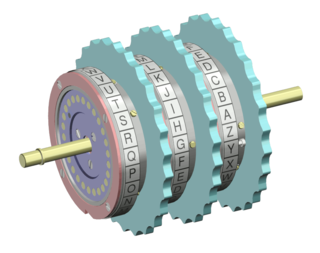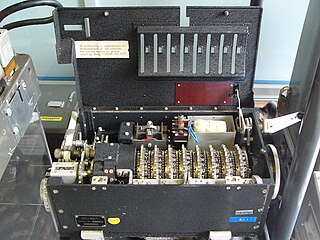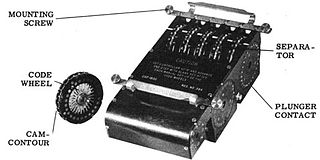Related Research Articles

In cryptography, a cipher is an algorithm for performing encryption or decryption—a series of well-defined steps that can be followed as a procedure. An alternative, less common term is encipherment. To encipher or encode is to convert information into cipher or code. In common parlance, "cipher" is synonymous with "code", as they are both a set of steps that encrypt a message; however, the concepts are distinct in cryptography, especially classical cryptography.

Cryptanalysis is the study of analyzing information systems in order to study the hidden aspects of the systems. Cryptanalysis is used to breach cryptographic security systems and gain access to the contents of encrypted messages, even if the cryptographic key is unknown.

The Enigma machine is an encryption device developed and used in the early- to mid-20th century to protect commercial, diplomatic and military communication. It was employed extensively by Nazi Germany during World War II, in all branches of the German military.

In the history of cryptography, Typex machines were British cipher machines used from 1937. It was an adaptation of the commercial German Enigma with a number of enhancements that greatly increased its security. The cipher machine was used until the mid-1950s when other more modern military encryption systems came into use.
Symmetric-key algorithms are algorithms for cryptography that use the same cryptographic keys for both encryption of plaintext and decryption of ciphertext. The keys may be identical or there may be a simple transformation to go between the two keys. The keys, in practice, represent a shared secret between two or more parties that can be used to maintain a private information link. This requirement that both parties have access to the secret key is one of the main drawbacks of symmetric key encryption, in comparison to public-key encryption.

In cryptography, a rotor machine is an electro-mechanical stream cipher device used for encrypting and decrypting messages. Rotor machines were the cryptographic state-of-the-art for a prominent period of history; they were in widespread use in the 1920s–1970s. The most famous example is the German Enigma machine, the output of which was deciphered by the Allies during World War II, producing intelligence code-named Ultra.

The Lorenz SZ40, SZ42a and SZ42b were German rotor stream cipher machines used by the German Army during World War II. They were developed by C. Lorenz AG in Berlin. The model name SZ was derived from Schlüssel-Zusatz, meaning cipher attachment. The instruments implemented a Vernam stream cipher.

The Siemens & Halske T52, also known as the Geheimschreiber, or Schlüsselfernschreibmaschine (SFM), was a World War II German cipher machine and teleprinter produced by the electrical engineering firm Siemens & Halske. The instrument and its traffic were codenamed Sturgeon by British cryptanalysts.
Cryptography, the use of codes and ciphers to protect secrets, began thousands of years ago. Until recent decades, it has been the story of what might be called classic cryptography — that is, of methods of encryption that use pen and paper, or perhaps simple mechanical aids. In the early 20th century, the invention of complex mechanical and electromechanical machines, such as the Enigma rotor machine, provided more sophisticated and efficient means of encryption; and the subsequent introduction of electronics and computing has allowed elaborate schemes of more still greater complexity, most of which are entirely unsuited to pen and paper.
The bomba, or bomba kryptologiczna, was a special-purpose machine designed around October 1938 by Polish Cipher Bureau cryptologist Marian Rejewski to break German Enigma-machine ciphers.

Alvis Car and Engineering Company Ltd was a British manufacturing company in Coventry from 1919 to 1967. In addition to automobiles designed for the civilian market, the company also produced racing cars, aircraft engines, armoured cars and other armoured fighting vehicles.
Cryptography was used extensively during World War II, with a plethora of code and cipher systems fielded by the nations involved. In addition, the theoretical and practical aspects of cryptanalysis, or codebreaking, were much advanced.

The FV603 Saracen is a six-wheeled armoured personnel carrier built by Alvis and used by the British Army. It became a recognisable vehicle as a result of its part in the policing of Northern Ireland as well as for its role in enforcing apartheid in South Africa. It is still in use in secondary roles in some countries.

Portex was a British cipher machine. A rotor machine, the device used eight rotors each with a tyre ring and an insert. The machine was used mainly by the secret services from the late 1940s to the early 1950s.

The Combined Cipher Machine (CCM) was a common cipher machine system for securing Allied communications during World War II and, for a few years after, by NATO. The British Typex machine and the US ECM Mark II were both modified so that they were interoperable.

Noreen, or BID 590, was an off-line one-time tape cipher machine of British origin.
Mercury was a British cipher machine used by the Air Ministry from 1950 until at least the early 1960s. Mercury was an online rotor machine descended from Typex, but modified to achieve a longer cycle length using a so-called double-drum basket system.
Vickers plc was the remainder of Vickers-Armstrongs after the nationalisation of three of its four operating groups: aviation, shipbuilding and steel. It was purchased by Rolls-Royce plc in 1999, and the Vickers company name became defunct in 2004.

Marian Adam Rejewski was a Polish mathematician and cryptologist who in late 1932 reconstructed the sight-unseen German military Enigma cipher machine, aided by limited documents obtained by French military intelligence. Over the next nearly seven years, Rejewski and fellow mathematician-cryptologists Jerzy Różycki and Henryk Zygalski developed and used techniques and equipment to decrypt the German machine ciphers, even as the Germans introduced modifications to their equipment and encryption procedures. Five weeks before the outbreak of World War II the Poles, at a conference in Warsaw, shared their achievements with the French and British, thus enabling Britain to begin reading German Enigma-encrypted messages, seven years after Rejewski's original reconstruction of the machine. The intelligence that was gained by the British from Enigma decrypts formed part of what was code-named Ultra and contributed—perhaps decisively—to the defeat of Germany.

Alvis Ltd. was created when United Scientific Holdings plc acquired the Alvis division of the nationalised vehicle manufacturer British Leyland in 1981. United Scientific maintained its own name until 1992 when the group was renamed Alvis plc. Alvis acquired Swedish armoured vehicle manufacturer Hagglunds AB in 1997 and the armoured vehicle business of GKN in 1998. Finally, it acquired Vickers Defence Systems from Rolls-Royce in October 2002. Alvis was acquired by BAE Systems in 2004 and became BAE Systems Land Systems , now part of the BAE Systems Land & Armaments operating group.
References
- ↑ Easter, David (2019). "Protecting secrets: British diplomatic cipher machines in the early Cold War, 1945–1970". Intelligence and National Security. 34 (2): 157–169. doi:10.1080/02684527.2018.1543749. S2CID 158622527.
- ↑ Aldrich, Richard (2010). GCHQ . Harper Press. p. 210. ISBN 9780007312665.
- 1 2 3 "BID 610 (Alvis)".